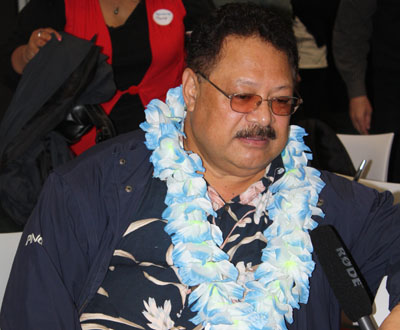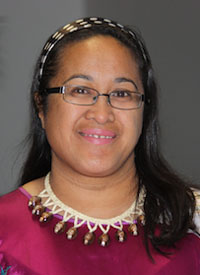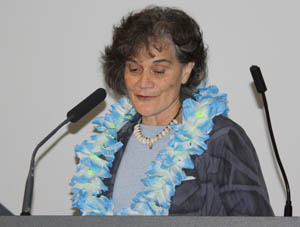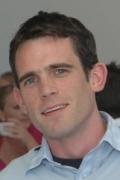
The Pacific Islands Media Association held its annual conference at AUT University. While many of the who’s who of Pacific media were present, it was a new generation of media students and people who caught the eye.
Iulia Leilua spoke of her 83-year-old father, an avid media consumer and the changes that have occurred in his lifetime. She speculated on what might change in another 83 years, concluding that the most important thing for Pacific journalists was “to serve”.“We need to be bold,” she said. “We need to stick together and we need to be local.”
Translating an ancient Samoan proverb, Pacific Islands Media Association chair Iulia Leilua said that to be a leader, one must serve.
The keynote speaker of the PIMA annual conference at AUT University was Tongan media leader Kalafi Moala, publisher and chief executive of Taimi Media Network. Moala spent 15 years in exile from his own country, due to censorship and persecution by the establishment.
He is now vice-chair of the newly formed Apia-based Pasifika Media Association (PasiMA).
“PasiMA means ‘concrete fortress’ in Samoan, and incidentally, it means the same thing in Tongan,” he said.
In his address, Moala attacked the censorship regime in Fiji, and explained why PasiMA was set up. But his warnings were not just limited to Fiji.
‘Losing battle’
“We seem to be fighting a losing battle,” he said. “There are new forces of media coming into the Pacific. They could be good, they could be bad.”
Moala was speaking about the emergence of Western voices in the islands, for example through the ABC’s 24-hour radio service.
He criticised some of the radio service’s “totally irrelevant” stories and told the audience his interview with the ABC – just before the conference started - was abruptly cut short when he criticised it of “token efforts”.
Moala also called for a measured approach to new technology, saying the islands were some years behind and that traditional media was still important.
“We seem to be less and less concerned about the content as we are with the method,” said Moala.
“We are able to produce very interesting, very creative trash.”
Moala finished with a thoughtful justification for the emergence of PasiMA in the Pacific. The main thrust is that he wants the focus to be back on people.
In Moala’s opinion, PINA has failed in its foundational purpose to stand for media freedom and while seeking to engage with the regime, has departed from the crucial focus on people - and switched to seeking political objectives.
Cultural clashes
The conference was an interactive affair, and Sandra Kailahi, secretary of PINA and convenor of the conference, chaired a panel discussion on media standards and the clashes with cultural standards.
Richard Pamatatau, from Radio New Zealand, voiced his frustration with newsroom decision-makers that simply did not “understand” what was important for Pasifika people. He lamented that his presence at times felt token, recalling that initially he was asked to bring in a tapa to the office, just to give the newsroom a “Pacific feel”.
Vaimoana Tapaleau, of the New Zealand Herald and 2010 Qantas Junior Reporter of the Year, spoke about inaccuracies and misspelling issues that could be offensive.
“It doesn’t take much to just check the facts,” she said. “It’s all about being fair, balanced and accurate, isn’t it?”
Tapaleau gave a recent example of TV3 programme Campbell Live’s coverage of the tsunami anniversary in Samoa, which has come under fire from the Samoan government in the last few days.
“I have a lot of respect for John Campbell,” said Tapaleau.
“But he was standing in a Samoan fale and saying there are no walls and no bedrooms - trying to point out that the aid money had not reached these people. But that’s a traditional Samoan fale; there are not meant to be walls or bedrooms.
“It’s a simple thing, but it shows you can’t just arrive at some place and start reporting. You have to try to understand the culture a little.”
Niva Retimanu from Newstalk ZB said that no matter how long a journalist had been in the business, he or she had to be ready to learn - and to apologise for getting things wrong.
“I have had to get used to saying sorry,” she said. “And even this year I have had to apologise a couple of times.
“But no matter whether you have been in news one year or 20 years, you have to be asking all the time, if you are not sure. You have to check you have the right word for what you are talking about.”
Panelists disagreed that Pasifika broadcasting was avoiding the hard-hitting angles and opting for a “rosy-picture” approach, as one question suggested, and Pamatatau went straight to the point.
“Our job is to report the news, to hold truth to power, and sometimes that is going to make people uncomfortable.”
A memorable aspect of this year’s conference was the practical DIY workshop on multimedia. Primary school students from Randwick Park School jumped into the teacher’s desk in the computer rooms, giving grown adults one-on-one tuition on how to make blogs, podcast and master the digital world.
Veteran becomes student
Tongan media veteran Sefita Hao’uli became a keen student for the session and passed with flying colours after setting up two different blogs in half an hour.
“I didn’t realise it could be so easy,” he said. PIMA’s AGM was held as part of the conference, with new members elected to the executive, although Iulia Leilua of Māori Television was unopposed as chair, Chris Lakatani returned as vice-chair and Sandra Kailahi re-elected as secretary.
PIMA’s AGM was held as part of the conference, with new members elected to the executive, although Iulia Leilua of Māori Television was unopposed as chair, Chris Lakatani returned as vice-chair and Sandra Kailahi re-elected as secretary.
Most notably, members voted unanimously for the formation of a working group on establishing a Pasifika broadcasting channel for New Zealand television. The group will be guided by the newly-elected PIMA representative for television, Setita Miller.
Dr David Robie, director of the Pacific Media Centre, gave a short address on behalf of the hosting AUT University and introduced members to the new Graduate Diploma in Pacific Journalism being offering from next year.
The atmosphere of the conference was a flurry of activity and conversation, with students approaching well-known Pacific media figures for advice or an interview for publication. Media personalities, so used to being on the other side in an interview, willingly complied and spoke freely of their concerns.
Cam Swainson-Whaanga from Tagata Pasifika took the attendants through the ropes of networking online, sending published works to multiple websites and contacts and in general, “getting as much exposure as you can, so that when people search, your work comes up as it has already had many hits”.
Swainson-Whaanga spoke of the “sales-pitch” when using multimedia platforms, making comparisons to marketing.
‘Cut-throat world’
At the same time, a popular session for producers was taking place. An authoritative panel of producers faced the music; with budding producers asking them, “What’s hot at the moment?” and not giving up until they got a straight answer.
“Look,” said Manutai Schuster, from Māori Television, “If you can’t tell your story in one sentence, then you don’t have a story.”
Chris Payne, development executive at the New Zealand Film Commission, said it was a “cut-throat world”.
“You really only have one chance to make a good impression,” he said.
“If there are sloppy mistakes and it’s not all together, then you may have missed your only chance.”
But Payne gave hope to young amateurs, saying “the old guard are getting too old sometimes,” to the chagrin of some of the more experienced members in the audience.
Plenty of advice was handed out, with Schuster instructing listeners to “be true to your own passion, stick with it and believe in it and that passion will come out in your production”.
Fewer Pacific proposals
Kathryn Graham from TVNZ told the audience that since the age of Māori Television, there were less Pacific people knocking on her door with proposals.
“As the New Zealand audience becomes more and more Pacific and more Asian, we need to look at this,” she said.
At the same time she mentioned that funding was now the biggest issue.
"It is not surprising that more and more of our stuff is coming from the same production people,” she said, which
However, Kathleen Anderson from TVNZ gave the listeners some encouragement saying, “don’t be put off by the first ‘no.’”
Anderson said that a new exciting brand of drama was emerging and should be experimented with – the docudrama, and used the example of Touching the Void as a “stunning piece of work”.
“There is a lot of drama on. We are looking for strong, character-based drama series that are unique and appealing to a broad audience,” she said.
Payne’s main message was that of awareness and exposure. “Get it on YouTube,” he said. “Get it seen, do it cheap. We will find you and if it’s good, we’ll give you more money to do it better.”
“Get it on YouTube,” he said. “Get it seen, do it cheap. We will find you and if it’s good, we’ll give you more money to do it better.”
The final panel session entitled, “The end of traditional media”, involved some veterans of the media, including Moala, Tom Etuata of the Pacific Media Network and Taualeo’o Stephen Stehlin, from Tagata Pa sifika.
Technology ‘is neutral’
Moala again insisted that “technology is in many ways neutral.” He said that it could be used to instruct people, but also to destruct, and that the content was most important.
“It has always been like that and will always be like that,” he said.
While Etuata was balancing use of his iPhone with his traditional paper and pen, Sefita Hao’uli pointed out that a good portion of the population was in the “mature” category and still learning about new and digital media.
However, Matilda Roebeck, a teacher at Tangaroa College in Otara, brought the attendants some perspective by pointing out that technology was flying ahead, but only for the few, not the many.
“The only way they are able to access the internet is at school or at public libraries and at both those places the resources are very much stretched,” said Roebeck of her students, 90 percent of whom are Pacific Islanders or Māori.
“Very few students have access to internet in their own homes.”
There are many challenges for PIMA in the next year, not least of all the goal of establishing the Pasifika television station.
There are of course their core objectives of encouraging more Pacific people to pursue media as a career and to strive for better representation of Pacific people in the media.
But members have rallied behind Leilua who was reelected not only for the sake of continuity, but for her commitment to the association. As it prepares to launch into its second decade, it has as good an opportunity as ever to achieve those goals.
Pictured: Middle: PIMA's Iulia Leilua ... inspirational words. Photo: Hamish Fletcher/PMC. Above: Tagaloatele Dr Peggy Fairbairn-Dunlop, foundation professor of Pacific studies at AUT University, welcomes participants. Photo: Kim Bowden/PMC



